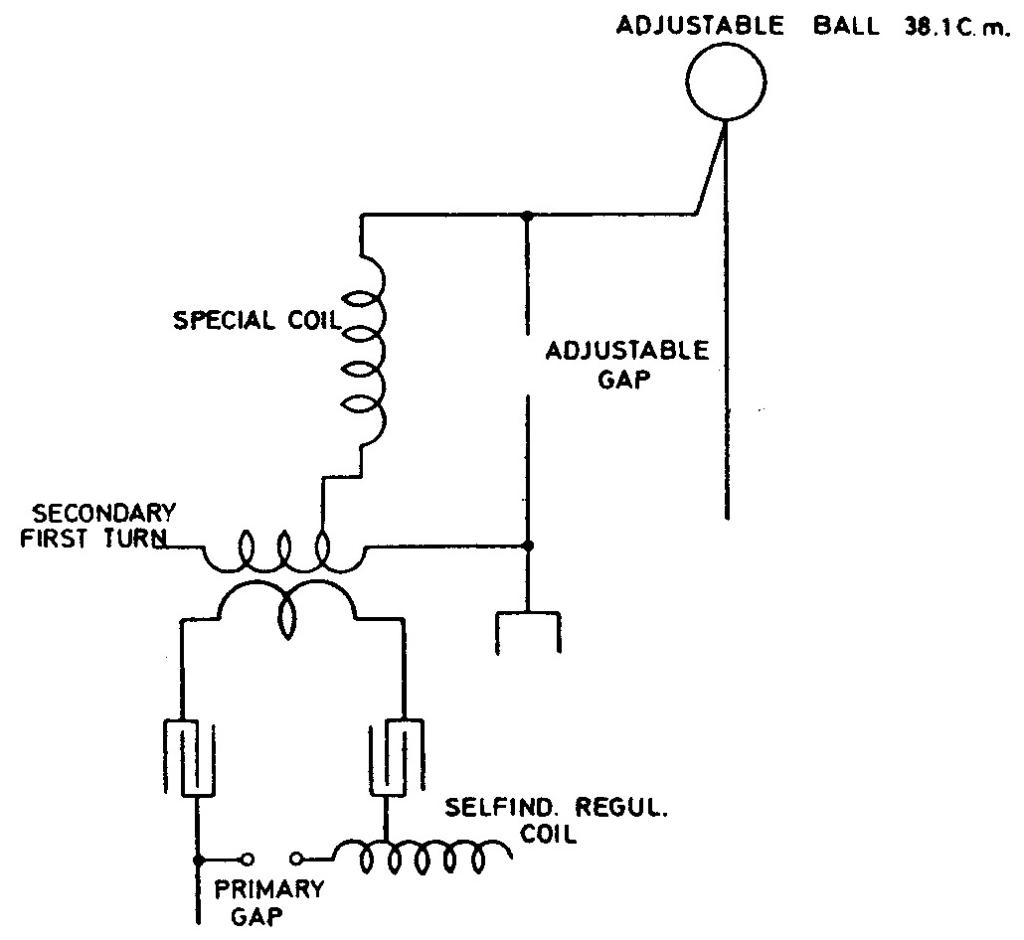
Nikola Tesla Books
Colorado Springs
Oct. 9, 1899
Today an other effort was made to ascertain more closely rate of increase of capacity of a body with the height above the ground. The same adjustable sphere was used and to eliminate some influences which might cause errors the special coil, which was rewound with same wire as before and had now 404 turns, the wire being wound a trifle higher, was connected to the first turn of secondary of oscillator, that is the turn first from the ground. This gave a small initial e.m.f. and reduced the error due to capacity very materially. (Here the distributed capacity is meant). Also, since the pressures developed were much smaller owing to small initial pressure on the special coil the streamers did not appear and did not therefore complicate the observations as in some previous cases. The plan of connections is clear from the diagram below.
The object was specially to obtain a number of values which were as closely determined as possible and with the ball in positions entirely above the building. Only three values could be obtained owing to darkness setting in, but these seemed fairly close as the tuning was done over and over with same results. These were as follows:
| Height of ball above ground | Turns in Reg. coil | Total self-ind in primary | Total capacity in pr. mfd. | ||||||||
|---|---|---|---|---|---|---|---|---|---|---|---|
| 35.66 feet | 22 |
|
8 tanks each side 0.15264 |
||||||||
| 34.66 " | 19 | 129,400 cm. | 0.15264 | ||||||||
| 33.66 " | 16 (trifle less) |
118,600 cm. | 0.15264 |
Now since the capacity in the primary was the same the capacity in the secondary varied directly as the self-induction of the primary. The above figures show that from 33.66 feet to 34.66 feet, that is an elevation of one foot, the increase was 9.1%, while for the next foot higher it was nearly 9.9% on the average, say, 9.5%. At this rate the increase
215
October 9
He continues to improve the method for variable capacitance measurement of a sphere by varying the height. Last measurements he performed on Oct. 5, but he did not provide the calculated values.
After that he was improving the apparatus as a whole, and changed the "special coil" connection method. "Weaker Link", which was a main characteristic of the change, indicated immediately its good characteristics. Less excited "special coil" was easier to be adjusted in resonance, because there were no current streamers. The effect of parasitic capacitance was reduced to mainly distributed capacitance of the "special coil". Prior to the sphere capacitance variation measurement related to height variation, he determines the "special coil" distributed capacitance. He assumes that the circuit with a sphere resonates at frequency Ï0, which is defined by oscillator primary circuit so that it could be written: Lp1Cp = Lsc(c + C), where Lp1 and Cp are total inductance (with the regulating coil included) and primary oscillator circuit capacitance, respectively. Lsc is ''special coil'' inductance (with inductances connections included). C is distributed or parasitic capacitance of the "special coil", and c is the sphere capacitance. At some other height only the sphere capacitance is changed in the circuit of the "special coil". In order to achieve the resonance between the system and the signal from the oscillator, Tesla varies the inductance in the primary circuit. When the generator frequency is equal to the resonant frequency of "free coil" circuit, according to Tesla, the following equation could be written: Lp2Cp = Lsc(c' + C).
Division of this equation by the previous one results in: c' = Lp2(c + C) - C, which corresponds to Tesla's equation from which c' is determined. Due to a calculation error when C was calculated, Tesla's various results for the sphere capacitance are higher by approximately 10%, but this does not essentially change the main conclusions. When calculating the coil distributed capacitance* he uses the relation LpCp = Lsc(c + C) for the sphere at a height, where he considers that its capacitance is close to the theoretical value for the remote sphere.
When commenting on results, he mentioned that this assumption could be the cause of the error.
* Under the term coil distributed capacitance Tesla considers the total capacitance among coil turns. Here he uses another definition "internal capacitance", which is similar to the one which is normally used even today.


